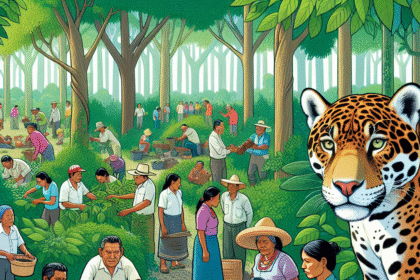Practicing Leave No Trace Principles in Tulum’s Lush Jungle
Understanding Leave No Trace Principles
The Leave No Trace principles encompass seven key guidelines designed to minimize human impact on the environment. These principles promote a sustainable approach to outdoor activities and are essential for preserving the delicate ecosystems found in places like Tulum’s lush jungle. The following seven principles serve as a foundation for eco-conscious exploration.
1. Plan Ahead and Prepare
The first principle emphasizes the importance of planning your trip effectively. Familiarize yourself with Tulum’s unique wildlife, plant life, and geographic features. Studying trail maps, understanding the weather, and checking local guidelines can enhance not only your experience but also preserve the environment. Many parts of Tulum are home to endangered species, making it crucial to follow marked paths to avoid disturbing their habitats.
2. Travel and Camp on Durable Surfaces
When exploring the jungle, always stick to established trails and camp in designated areas. This practice helps prevent the destruction of vegetation and soil erosion. In the Tulum jungle, consider using durable surfaces like rocks, dry grass, or existing campsites. By minimizing your footprint, you can protect sensitive areas from being damaged by increasing foot traffic.
3. Dispose of Waste Properly
Always carry out what you bring in. This includes food waste, wrappers, and personal items. The Tulum jungle is not equipped with adequate waste disposal facilities, and litter can harm wildlife and obscure natural beauty. Make use of portable trash bags specifically designed for hiking, and if you find litter, take the initiative to remove it, promoting a cleaner environment for future visitors.
4. Leave What You Find
Observe wildlife and natural formations without disturbing them. In Tulum’s expansive jungle, you may encounter unique plants, rocks, or even archaeological artifacts. Taking items from their natural environment can destabilize local ecosystems. Capture memories with photographs but leave natural and cultural objects behind for others to appreciate.
5. Minimize Campfire Impact
If you must have a fire, ensure it’s in a permissible area and stick to established fire rings. Gather only dead and downed wood to minimize the impact on live trees and surrounding vegetation. In Tulum, consider using a portable camp stove for cooking instead of a traditional campfire, as it leaves a smaller ecological footprint and reduces the risk of wildfires in this densely wooded area.
6. Respect Wildlife
Wildlife in Tulum’s jungle should be admired at a distance. Feeding animals disrupts their natural foraging behavior and can lead to aggression or dependency on human food. Keep a safe distance from all wildlife, and avoid using flash photography, which can startle animals and disturb their natural behaviors. Equip yourself with binoculars for a better view without intruding.
7. Be considerate of Other Visitors
Keep noise levels to a minimum and maintain a cordial atmosphere with fellow adventurers. Respect other people’s experiences by being courteous on trails. If you encounter others on narrow paths, step aside to let them pass while maintaining physical distance to protect from any spread of invasive species. Leave areas cleaner than you found them and practice kindness, embodying the spirit of ecotourism.
Enhancing Your Tulum Experience Through Sustainability
Implementing Leave No Trace principles enhances your visit to Tulum by fostering a deeper connection to its tropical wilderness. Engage local guides to educate yourself about the area’s biodiversity and cultural history. These guides can offer insights into native plants, animals, and the best practices in sustainable tourism.
Responsible Photography
When capturing the beauty of Tulum’s jungle, consider ethical photography practices. Avoid intrusive shots that may require disturbing wildlife or vegetation. Respect private property and sacred sites; always ask for permission if photographing individuals or locations critical to the local culture. Using a drone can disrupt wildlife in Tulum, so ensure compliance with local laws regarding aerial photography.
Participating in Volunteer Initiatives
Local organizations often host clean-up drives and reforestation projects in and around Tulum. Participating in these initiatives helps restore ecosystems while offering genuine engagement with the community. Not only does volunteering improve the environment, but it also enriches your travel experience through learning opportunities and new friendships.
Choosing Eco-friendly Accommodations
When selecting where to stay in Tulum, opt for accommodations that prioritize sustainability. Look for lodgings that employ energy-saving practices, maintain recycling programs, and implement water conservation strategies. Many eco-friendly hotels also support local businesses, allowing you to immerse yourself in Tulum’s culture while keeping environmental impacts to a minimum.
Navigating with Active Awareness
Stay vigilant while cruising through Tulum’s lush jungle. This entails paying attention to trail markings, watching for potential hazards, and recognizing the presence of wildlife. Active awareness not only ensures your safety but also demonstrates respect for the natural environment.
Understanding the Cultural Significance of the Jungle
Recognize that Tulum’s jungle holds cultural significance for many indigenous groups. Learning about the historical context and importance of these lands encourages respect and appreciation for the traditions tied to this picturesque setting. Participating in workshops led by local communities can further deepen your understanding of their cultural heritage.
The Importance of Seasonal Awareness
Timing your visit can significantly impact your experience and the ecosystem. Timing your trip outside of peak tourist seasons allows for less crowded spaces and minimizes impact on wildlife. Additionally, understanding the seasonal behaviors of local fauna aids in responsible viewing and can enhance wildlife observation opportunities.
Promoting Environmental Education
Share the knowledge of Leave No Trace principles with fellow travelers and locals. Whether through informal conversations or participating in environmental education sessions, fostering an understanding of sustainable practices cultivates a community dedicated to protecting Tulum’s lush jungle.
Staying Informed About Local Regulations
Travelers should always stay updated on local regulations regarding wildlife protection, trail usage, and conservation initiatives. Many areas within the Tulum jungle may have specific rules aimed at preserving natural resources. Familiarize yourself with these regulations to ensure you’re conducting yourself in accordance with local conservation efforts.
The beauty of Tulum’s lush jungle is unparalleled, but it requires responsible stewardship to maintain its splendor for future generations. Through dedicated practices grounded in Leave No Trace principles, visitors can enjoy the wonders of nature while ensuring the preservation of this vital ecosystem. By embracing eco-conscious behaviors, you contribute to the health of Tulum’s jungles, fostering an experience enriched by both nature and culture.







